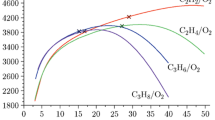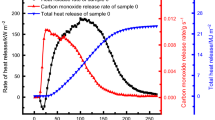Abstract
Investigations of the thermal stability of detonating fuse containing 10 g pentaerythrol tetranitrate (PETN) revealed that the cord burnt under unconfinement at 403 K. Under confinement in a steel pipe or copper tube there was a partial detonation at 403 K. In order to characterize the thermal stability of PETN and pyrotechnic composition used in fuse head of electric detonators differential thermal analysis (DTA) was used.
The electric detonators of aluminium cell and copper cell were heated from ambient temperature to 373 K at an average rate of 0.4 deg/min. The rate of heating was increased gradually to 1.5 deg/min till explosion. The detonation temperature varied between 373 K and 375 K.
The impact and friction sensitivity of detonating fuse was poor. There was no detonation when a 5 kg hammer was repeatedly hit over the fuse from a height of one metre. There was no detonation when the detonating fuse was rubbed by a blunt edge of steel plate till it was smashed.
Zusammenfassung
Untersuchungen der thermischen Stabilität von Sprengschnuren mit 10 gm−1 PETN zeigten, daß die Schnur frei bei 403 K verbrennt. Unter Abschluß in einem Stahloder Kupferrohr tritt bei 403 K eine partielle Detonation auf. Zur Charakterisierung der thermischen Stabilität von PETN und von pyrotechnischen Mischungen, die in Zünderköpfen von elektrischen Sprengkapseln verwendet werden, wurde Differentialthermoanalyse (DTA) angewendet. Die elektrischen Sprengkapseln von Aluminium- und Kupferzellen wurden mit einer durchschnittlichen Aufheizgeschwindigkeit von 0.4 Grad/min von Raumtemperatur auf 373 K erhitzt. Die Aufheizgeschwindigkeit wurde bis zur Explosion allmählich auf 1,5 Grad/min erhöht. Die einzelnen Detonationen erfolgten bei einer Temperatur zwischen 373 und 375 K. Die Stoß- und Reibempfindlichkeit der Sprengschnur war gering. Bei einem mehrmaligen Einwirken eines 5 kg-Hammers aus einer Höhe von 1 m erfolgte keine Detonation. Bei Reiben mit der unscharfen Kante einer Stahlplatte bis zur Zerstörung erfolgte keine Detonation.
Резюме
Исследование термоу стойчивости детонирующего запал а, содержащего 10 гм−1 PETN, показали, что в откры том пространстве шну р зажигался при 403 К, При п омещении его в стальную или медную т рубу происходила час тичная детонация его при тем пературе 403 К. Для определения термоус тойчивости PETN и пироте хнического состава, используемо го в головке запала электрически х детонаторов, был исп ользован дифференциальный те рмический анализ. Электрические детон аторы с алюминиевой и медной ячейкой нагревались от комнатной температуры до 373 К со с редней скоростью наг рева 0,4°/мин. Затем скорость нагре ва постепенно увеличив али до 1,5°/мин до самого взрыва. Температура детонац ии менялась между 373 и 375 К. Малочувствитель ным оказался детонир ующий запал к ударному дейс твию и трению. Детонация не п роисходила даже при многоразовом ударе 5 к г молотом по нему с высоты 1 м. Детонация не происходила также и т огда, когда запал подверга лся трению до его полного разрушения.
Similar content being viewed by others
References
A. K. Chattopadhyay and S. Seshan, A. Technical report, Indian Explosives Ltd., Gomia 1986.
A. K. Chattopadhyay and S. Seshan, Proceedings of the Vth Symposium on thermal analysis IIT, Kharagpur, Dec. 20–22, 1985, 5.35.
P. S. Makashir and E. M. Kurian, Proceeding of Vth Symposium on Thermal Analysis, IIT, Kharagpur, Dec. 20–22, 1985, 5.57.
M. Hemmila, I. Heroinen and A. Karimiem, Propellants, Explosives and Pyrotechnics, 11 (1986) 91.
H. E. Kissinger, Anal. Chem., 29 (1957) 1702.
T. Ozawa, J. Thermal Anal., 2 (1970) 301.
T. Ozawa, Bull. Chem. Soc., Japan, 38 (1965) 1981–1986.
R. N. Rogers and E. D. Morris, Anal. Chem., 38 (1966) 412.
Author information
Authors and Affiliations
Additional information
The authors are indebted to the Director, Central Mining Research Station for giving permission to publish this paper. The views expressed in the paper are those of the authors and not necessarily of the institute which they belong to.
Rights and permissions
About this article
Cite this article
Nabiullah, M., Gupta, R.N. & Singh, B. Studies on the thermal behaviour of detonating fuse and detonators. Journal of Thermal Analysis 35, 1165–1172 (1989). https://doi.org/10.1007/BF01913034
Issue Date:
DOI: https://doi.org/10.1007/BF01913034




